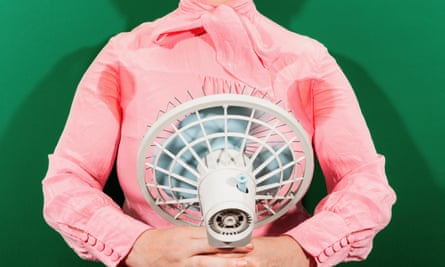It’s getting hot again – and that means sweat. With the possible exception of Prince Andrew, humans are constantly producing “insensible perspiration” – the baseline level of sweat – to some degree. Despite that, we know surprisingly little about it. According to Sarah Everts, the author of The Joy of Sweat, which explores the science, culture and history of sweat and our attempts to fight it, there is “a dearth of sweat research; there’s so much more fundamental research on every other body fluid”. So what do and don’t we know?
It’s a gift to humanity
Other mammals sweat, but not quite like we do. Humans have between 2m and 4m eccrine (eternally secreting) sweat glands; that is 10 times as many as a chimpanzee. Our fine hair makes the evaporation of sweat from the skin surface, which is how we cool down, easier.
“In terms of our efficiency, in cooling down with sweat, we are a complete superpower,” says Everts. In the past, our cooling ability enabled us to continue hunting in the hottest parts of the day, when other mammals had to stay in the shade and limit activity. If you end up dripping when you run out to buy your lunchtime sandwich, drip proudly: you are showing off the hunting strategy of your forebears; it is partly what made us more successful than other, hairier mammals.

It’s a lot better than the alternatives
We may find sweating embarrassing, but there are worse cooling strategies: storks defecate on their legs (it’s more palatably called urohidrosis); fur seals urinate on rocks to wet their bellies and flippers, then hold up their wee-soaked flippers to cool, and honeybees essentially vomit on themselves. When hippos “sweat blood”, as the myth goes, it is neither sweat nor blood: it’s more of a moisturiser.
Meanwhile, if it applies to the whole body, anhidrosis – the medical condition that renders you unable to sweat – can be life‑threatening, as can hypohidrosis, where you sweat less than usual. Without this essential cooling strategy, sufferers risk heat exhaustion and heatstroke.
Sweat is revealing
Because sweat is in part sourced from interstitial fluid – essentially the liquid parts of blood – there is all sorts in there: testing sweat can detect the presence of caffeine, alcohol, cocaine – or even spicy tomato NikNaks. Everts tells a story in her book of a South African nurse who was terrified when her sweat turned red; it turned out she had been bingeing on the luridly coloured snacks. The diagnostic test for cystic fibrosis is a sweat test that measures the amount of salts (chloride) that sweat contains, as people with that condition have far higher levels than those who don’t.
Men and women sweat similar amounts …

Women tend to have more sweat glands than men, but research suggests that neither sex sweats “more” than the other. The amount you sweat seems to be more dependent on body size and shape than sex.
… but we probably smell quite different
A new study suggests that it may be possible to distinguish between men and women on odour alone. Researchers asked 60 volunteers to squeeze cotton gauze in their unwashed hands for 10 minutes, then analysed the chemical profile of the volatile organic compounds (mainly derived from sweat) that make up a person’s scent. They were able to distinguish gender with 97% accuracy.
Armpit sweat is a different beast
We have eccrine sweat glands almost all over our bodies, but our armpits, groin and the skin around our nipples also house apocrine glands. These are activated at puberty and produce sweat with a different composition than that from the rest of our bodies; it is fattier, more viscous and higher in protein.
BO is a complex cocktail
“Body odour is a mix of different chemicals,” says Prof Gavin Thomas as he shows me around his BO laboratory (he doesn’t call it that) at the University of York. Thomas and his team have been studying how particular skin bacteria (staphylococcus hominis) interact with sweat from the apocrine glands to create the bouquet of eau de sweaty human that scents our summers.
“The smell comes from microbial transformation,” he says. “Microbes ‘eat’ odourless molecules that are in our sweat and turn them into things that they can grow on. A byproduct that they ‘poop’ out is a molecule called a thioalcohol that is one of the key molecules we recognise as body odour.” One of the lab’s big breakthroughs has been identifying the enzyme that allows bacteria to do that.
Thioalcohol contains sulphur, which humans are able to detect at extremely low thresholds. That makes the PhD student Reyme Herman, who kindly whips me up some BO, quite unpopular in the lab: “All the nasty looks come to me.” He synthesises it for me in a fume cupboard and gives me a sniff. “Does it smell like body odour to you?” he asks. It’s oniony, I say. “Exactly. This molecule is quite oniony.”
There are other compounds in BO, particularly volatile fatty acids, which are also “eaten” by bacteria, creating a musky stench, but everyone’s bouquet is different.
READ RELATED: ‘Everything you’ve been told is a lie!’ Inside the wellness-to-fascism pipeline
We don’t know why we smell
The biochemical phenomenon that Thomas’s team have identified – a microbe transforming an odourless molecule – is also seen around hyena anuses. Also, it’s what cats do when marking their scent with their pee: use smell as social communication. That might be the original purpose of human BO, too. Some interesting research published last year on friends who instantly “clicked” suggests they tend to have similar smell profiles. However, as Thomas says: “We have no idea.”
You might be able to get an armpit transplant one day

If you have bad BO – or “axillary malodour”, to give it its technical term – Dr Armpit, the Belgian bioengineer Dr Chris Callewaert, might be able to help you one day. His lab is trialling armpit microbiome transplants, replacing stinky ones with a “non-odorous microbiome”. A donor, usually a close family member, stops washing for several days, while the recipient washes thoroughly and uses topical antibiotics to kill their armpit bacteria. They then “transplant” the donor bacteria to the pristine pit. Results on 18 trial patients have been “very promising”, apparently.
Antiperspirant deodorants haven’t really changed since they were invented
One of the earliest antiperspirants from the turn of the 20th century, Odorono, was so acidic that it was described in an American Medical Association investigation as a “violent irritant”; it also turned your armpits red. But the basic mechanism for stopping sweat and odour has not changed in more than 120 years, with most formulations still based on an aluminium salt, which clogs sweat pores, cutting off bacteria from their food source. There are, however, alternatives in the offing. Callewaert’s lab has trialled “probiotic deodorant” – spray-on good armpit bacteria – with encouraging results.
There is an artificial sweat industry
“It’s a delight to me that it exists,” says Everts, who bought some while researching her book. Artificial sweat comes in almost as many varieties as Heinz, depending on what it is needed for. Clothing, shoe, jewellery, musical instrument string and phone and tablet manufacturers all want to explore how saltiness and pH (sweat is slightly acidic) affect their products, while forensic laboratories need a different blend for creating control fingerprints.
The ‘sweating sickness’ is still a mystery
An epidemic characterised by profuse, foul-smelling sweating ravaged England in five deadly waves between 1485 and 1551, possibly even killing Henry VIII’s older brother Arthur, but we still don’t know what it was.
Suggested causes have included typhus, a tick- or mosquito‑borne virus or a hantavirus (a group of viruses mainly transmitted by rodents). But, as a 2014 paper speculating on its origins concluded, it’s a medical mystery – “and will most probably remain so”.
Sweating won’t detox you

A sauna won’t help your body remove impurities – that is what your kidneys are for. “It’s the most common misconception,” says Everts. “Quite frankly, if you were to detox by sweating, this would ultimately kill you, so it’s really great we don’t.” Anything in your bloodstream will be present in your sweat.
Everts believes this misconception derives from the fact sweating a lot feels good. “You definitely produce a lot of molecules that make you feel good – ‘runner’s high’ molecules. So you think that you have this emotional catharsis, but there is not a corresponding chemical catharsis.”
You wouldn’t want to sweat in space

In space, sweat doesn’t evaporate. Without gravity to wick moisture away from the skin, sweat sort of hangs around unless you wipe it away. During spacewalks, when they can’t do that, astronauts have to use other strategies, including wearing special cooling underwear and sweat-absorbing headbands and gloves.
Fearful sweat is different and we can smell it (or, at least, women and dogs can)
The chemical composition of what we sweat when we are scared is different from what we sweat when we are hot. Researchers at Utrecht University’s Smell Lab collected samples from men who had watched either horror films or neutral, relaxing shows (one was called Rail Away, a TV show filmed from a train travelling through meditative landscapes). The sweat collected from the horror movie group had a different chemical composition from that of Rail Away viewers.
In an earlier experiment by the same lab, women exposed to fear sweat generated by horror movie viewers screwed their faces up in a “fear response”, even when they were themselves watching something neutral. Men, however, did not. In a separate study, dogs accurately identified a stress sweat sample 94% of the time. I leave you to draw your own conclusions.

Smelling other people’s sweat may assist with social anxiety (even if they were scared)
Early research this year from the Karolinska Institute in Stockholm explored whether sniffing sweat from strangers might help alleviate social anxiety. In conjunction with a mindfulness therapy session, it seemed to (although the sample size was tiny: 48 women). There was a 39% reduction in reported anxiety scores, compared with a 17% reduction in the therapy-only group. However, oddly, it did not appear to matter whether the sweat donor had been watching Mr Bean’s Holiday or a horror film.





